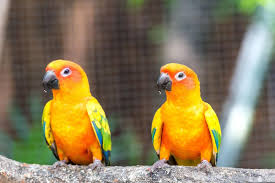Sun Conure

Description
The sun parakeet or sun conure (Aratinga solstitialis) is a medium-sized, vibrantly colored parrot native to northeastern South America. The adult male and female are similar in appearance, with predominantly golden-yellow plumage and orange-flushed underparts and face. Sun conures are very social birds, typically living in flocks. They form monogamous pairs for reproduction, and nest in palm cavities in the tropics. Sun conures mainly feed on fruits, flowers, berries, blossoms, seeds, nuts, and insects. Conures are commonly bred and kept in aviculture and may live up to 30 years. This species is currently threatened by loss of habitat and trapping for plumage or the pet trade. Sun conures are now listed as endangered by the IUCN.
On average, sun parakeets weigh around 110 g (4 oz) and are around 30 cm (12 in) long. They are sexually monomorphic.
Adults have a rich yellow crown, nape, mantle, lesser wing-coverts, tips of the greater wing-coverts, chest, and underwing-coverts. The face and belly are orange with red around the ears. The base of the greater wing-coverts, tertials, and base of the primaries are green, while the secondaries, tips of the primaries, and most of the primary coverts are dark blue. The tail is olive-green with a blue tip. From below, all the flight feathers are dark greyish. The bill is black. The legs and the bare eye-ring are grey, but the latter often fades to white in captivity (so using amount of grey or white in the eye-ring for determining "purity" of an individual can be misleading). It is easily confused with the closely related jandaya parakeet and sulphur-breasted parakeet, but the former has entirely green wing-coverts, mantle, and vent, while the latter has green mottling to the mantle and less orange to the underparts. The sun parakeet is also superficially similar to the pale-billed golden parakeet.
Juvenile sun parakeets display a predominantly green plumage and resemble similar-aged sulphur-breasted parakeets. The distinctive yellow, orange, and reddish colouration on the back, abdomen, and head is attained with maturity.
Scientific Name
Aratinga Solstitialis
Country Of Origin
Size
Life Expectancy
Noise Level
Talk / Trick Ability
Fair
Characteristics
Recognized for their beautiful plumage, sun conures are also known for their vocalizing. They are intelligent, playful, and are quieter if kept as single pets. Sun conures make good pet birds for a family because of their sociable, upbeat and affectionate personality. They have an adventurous attitude and are quite active. Owners find that sun conures enjoy playing on the floor, making foot toys appropriate for these birds. They entertain themselves by playing in their water bowls or during bathtime. With the ability to pick up words and phrases, sun conures are often described as being inquisitive.
Behavior / Health Concerns
Sun Conures need plenty of entertainment and interaction. Sun conures are susceptible to feather picking and common psittacine diseases. This pet bird’s diet needs to remain varied in order to keep a healthy pet. In addition to a pellet-based diet, sun conures need fresh fruits, vegetables and whole-grains.
Expert Advice
“Like the other Aratingas, rowdy little clowns who make lots of noise.”
Liz Wilson, CVTm CPBC